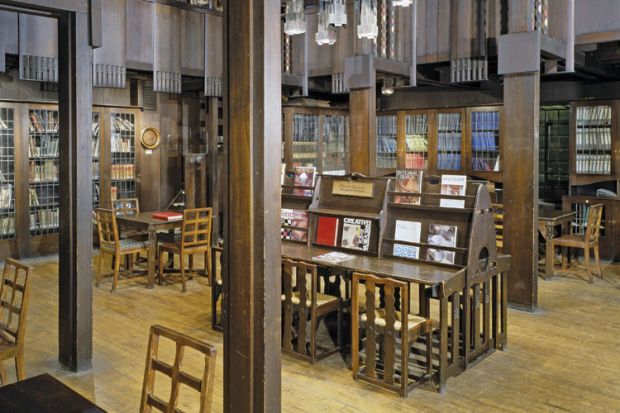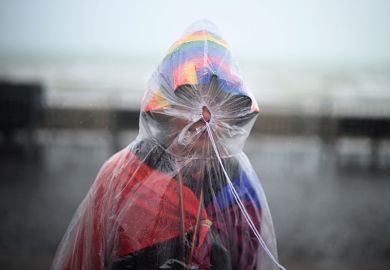“It felt like a death,” said Robyne Calvert, recalling the aftermath of the fire that ripped through Glasgow School of Art’s historic Mackintosh Building.
As an art historian specialising in the work of Charles Rennie Mackintosh, Dr Calvert felt the destruction of the famous library and its original furniture in May last year particularly keenly.
“I stood on the corner watching my favourite room in the world burn,” she said. “It was heartbreaking.”
But after death comes new birth, and in this case Miami-born Dr Calvert is playing a key role.
As the school’s recently appointed Mackintosh research fellow, she is coordinating projects inspired by the rebuilding of the Art Nouveau masterpiece.
The fire was powerfully destructive, but it was also surprisingly revealing, Dr Calvert said. For the first time since the Edwardian era, it is possible to see exactly how parts of the building were fashioned and fitted together.
And it is clear now that although the finish of the library featured the attention to detail that typified the Arts and Crafts Movement, the construction techniques are better likened to shop-fitting, Dr Calvert said. Nails were inserted “where they needed to be” rather than being placed according to some grand design.
Paint surfaces have also been revealed, showing the studios’ original sage green to be “completely different” from any hue that contemporary experts expected to find.
“Even when we were unpicking the building, we were learning more about the collection,” Dr Calvert said. “I thought it would be amazing if we could have someone in place leading research which was not needed to restore the building but which arose from that process.”
Some of the projects being coordinated by Dr Calvert will explore the history of the Mackintosh Building and its evolution over time – the fire exposed just how much the building had changed over the course of a century.
Another initiative will look at how the spatial and technical data being collated for the reconstruction programme can be visualised and turned into a tool that will allow researchers and Mackintosh enthusiasts to learn more about the building.
Conferences and symposia are planned, and the possibility of holding events in the library space before rebuilding begins is being considered. Unsurprisingly for an art school, creative responses to the fire will also be encouraged.
Dr Calvert is interested in exploring one further research avenue: the question of whether the library should be rebuilt at all.
For her, this goes to the centre of the debate about where authenticity lies in architecture and art.
In Scotland, and around the world, some experts have argued that the original spirit of the library cannot be recreated, that rebuilding is not something that Mackintosh would have wanted. The end result, such critics fear, could be a sort of “Mockintosh”.
Dr Calvert, however, takes a different view.
“He [Mackintosh] was a revivalist, taking interesting historical styles and reinventing them,” Dr Calvert said. “If something is based on the original design, if it was not handcrafted by him in the first place, where does authenticity lie?”
The school has settled on rebuilding according to Mackintosh’s original designs, albeit with some modern add-ons such as heating and cabling. It is hoped that most of the building will reopen for the 2017‑18 academic year.
Dr Calvert believes that this decision, coupled with the research projects, will allow the school to move on from the fire.
With the period of “mourning” having passed, and reassured by the knowledge that firefighters managed to save 90 per cent of the building, Dr Calvert said that she found the research opportunities “very exciting”.
“We have had a year to deal with the loss, and now we can only move forward,” Dr Calvert said. “The majority of the school and the collection is absolutely fine, and the part that has been lost is the most heartbreaking part of it, but there’s nothing else to do but take what positives we can and turn it into something we are learning from.”
In numbers
1,825 – the number of students at the Glasgow School of Art in 2013-14
Campus news
SRUC/University of Edinburgh
Plans for a merger between SRUC (Scotland’s Rural College) and the University of Edinburgh have been dropped. The pair announced in March 2014 that they were considering “enhanced strategic alignment”, and since then the possibility of SRUC’s becoming a school of the university has been discussed. But on 24 June, the institutions said that they had “agreed to build on their existing strong relationship and to continue to work closely as independent institutions”.
Newman University
A team led by a researcher at a Catholic university has been awarded £1.9 million by the Templeton Religion Trust to “examine the relationship between science and religion in society”. Led by principal investigator Fern Elsdon-Baker, who is based at Newman University in Birmingham, researchers will look to “provide fresh insights on how best to engage sceptical faith or non-faith publics with both evolutionary science and wider STEM issues”.
Aberystwyth University
Students called off a sit-in after assurances were given about the future of a Welsh-language hall of residence. The week-long demonstration was held to protest against Aberystwyth University’s proposal to close Pantycelyn Hall for refurbishment without a timetable to reopen it. The action ended after the university pledged that Pantycelyn would reopen within four years, and that alternative Welsh-medium accommodation would be provided in the meantime.
Royal Holloway, University of London
Bosnian actor Zana Marjanović has addressed an international conference on the Srebrenica massacre, which was held at a university ahead of the 20th anniversary of the infamous genocide. The star of In the Land of Blood and Honey, Angelina Jolie’s directorial debut, which is set during the Bosnian war, Ms Marjanović delivered the keynote speech at the event at Royal Holloway, University of London on 29 June. The massacre of more than 8,000 Bosnian Muslim men and boys in a UN-protected area in 1995 will be commemorated on a memorial day on 11 July.
University of Central Lancashire
A university-hosted conference has celebrated a “trailblazing” programme carried out in prisons in the North West of England. The Go Beyond conference at the University of Central Lancashire focused on Greener on the Outside: Prisons and Probation (GOOP), a horticultural and environmental conservation project aimed at enhancing the physical, mental, social and environmental well-being of offenders and their families, with the aim of reducing reoffending rates.
University of Lincoln
A university has announced a major new programme of investment in academic buildings and facilities after securing £130 million of funding. Money from the Higher Education Funding Council for England, the local enterprise partnership, Siemens and the European Investment Bank will support the project at the University of Lincoln. To mark the announcement, a giant beacon was lit by MARC, a robot created in the university’s School of Computer Science.
University of Nottingham
The head of a UK university has been honoured with a Festschrift to celebrate his scholarly work. Sir David Greenaway, vice-chancellor of the University of Nottingham, is honoured in a special edition of Review of International Economics. The edition showcases Sir David’s contributions to research in international economics and features articles from internationally renowned economists with close links to the scholar.
Soas, University of London
A new undergraduate degree is to focus on philosophy from Asia, Africa and the Middle East. The BA in world philosophies at Soas, University of London, to start in 2016‑17, will cover core topics in European philosophy but will also allow students to cultivate a specialism in philosophical thought found further afield and to learn a relevant language. According to Cosimo Zene, the programme leader, the course shows that Soas “welcomes the clearer presence of other systems of thought and philosophies”.
POSTSCRIPT:
Article originally published as: How rebuilding from blaze kindles new knowledge (2 July 2015)
Register to continue
Why register?
- Registration is free and only takes a moment
- Once registered, you can read 3 articles a month
- Sign up for our newsletter
Subscribe
Or subscribe for unlimited access to:
- Unlimited access to news, views, insights & reviews
- Digital editions
- Digital access to THE’s university and college rankings analysis
Already registered or a current subscriber? Login




